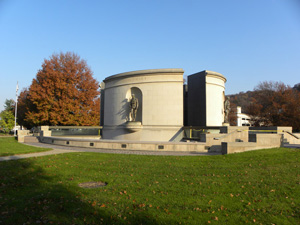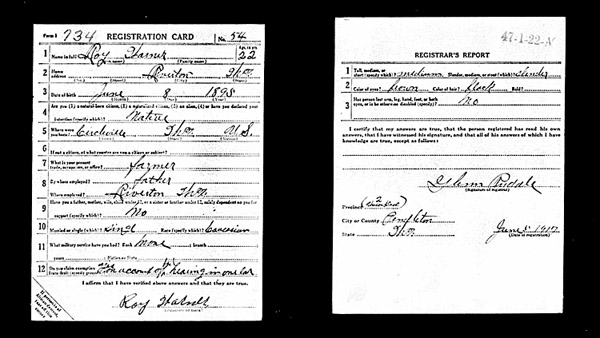

Remember...
Roy Warner
1895-1918
"When it came to treating influenza patients, doctors, nurses and druggists were at a loss."
Office of the U.S. Public Health Service Historian
 |
Remember...Roy Warner
|
Roy Warner was born on July 8, 1895, at Circleville in Pendleton County, West Virginia, to Ashby Warner and Cecilia ("Celia") Sponaugle Warner. Ashby and Celia were married on January 31, 1885, in Pendleton County. They were the parents of eleven children born at Circleville. The Warner children were: Lura May (Mrs. Alonzo Clarence Arbaugh); Joseph Lloyd; Thurman, who died young; Laura Alice (Mrs. Albert Solon Nelson); Tina (Mrs. Olie Judy); Zola Denver; Roy; Jesse C.; Grace (Mrs. Curtiss Patrick Bland); Carroll Stellman; and an unnamed child who died in infancy.
In the 1910 U.S. Census, fourteen-year-old Roy was listed as a farm laborer on his father's farm.
Cecilia Warner, Ray's mother, died on May 27, 1914, from hemorrhage of the lungs. She was buried in the Ashby Warner Family Cemetery in Teter Gap in Germany Valley, Pendleton County. Roy's father, Ashby Warner, remarried on November 23, 1918, at Riverton in Pendleton County to Pearlie Thompson Judy. He died on February 25, 1930, and is buried in the Ashby Warner Family Cemetery. Pearlie died on May 27, 1930, and is buried in the John Thompson Cemetery in Pendleton County.
Following the sinking of American merchant ships by German submarines, the United States declared war against Germany on April 6, 1917. When the call for volunteers failed to produce the needed one million troops to support the war effort, the Selective Service instituted a draft, with the first registration on June 5, 1917, for all men between the ages of 21 and 31.
Joseph Lloyd Warner, Roy's older brother who was 29 years of age, registered in Pendleton County for the initial World War I draft on June 5, 1917. He claimed an exemption to the draft because he was married and the father of a child who depended upon him for support. Joseph was employed by his father on the farm in Riverton. His draft registration card indicates he was of medium height and stout, with brown eyes and black hair.
Another brother, Zola Denver Warner, also registered for the draft in Pendleton County on June 5, 1917. He was 24 years of age and a farmer working on his father's farm in Riverton. His draft registration notes he was single. The descriptive portion of the record shows he was of medium build, with dark blue eyes and black hair. He claimed an exemption to the draft because his family was dependent on him to work on the farm. Zola lost his life in an auto accident in 1924.
Roy Warner also registered for the initial draft in Pendleton County on June 5, 1917. He was 22 years of age, single, and working for his father as a farmer at Riverton. Roy claimed exemption from the draft because of defective hearing in one ear; however, it appears that these exemptions were often not honored. His draft registration card describes him as being of medium height and slender, with brown eyes and black hair.

World War I draft registration card for Roy Warner. National Archives and Records Administration
The third registration for the draft began on September 12, 1918, for men ages 18 through 45. Jesse C. Warner, Roy's younger brother, having reached the age of 20, registered for the draft in Pendleton County on September 12. He was also working on his father's farm in Riverton. He was of medium height and had blue eyes and black hair. Thus, four of the five Warner men were registered for the draft in their home county; only the youngest:Carroll:escaped the registration process.
On August 27, 1918, Roy Warner left his home in Pendleton County for Camp Greenleaf in Chickamauga, Georgia. He arrived by train on the morning of August 31 and was temporarily assigned to Detention Camp Battalion No. 15, Company No. 11. With minor changes to spelling and grammar for the sake of clarity, his initial post card to H.M. Calhoun reads as follows:
Mr. H.M. Calhoun
Dear Sir
We got here on the 31st morn about 8 o'clock. We surely had a good time and a nice trip. We had lots of fun on the train. It was real warm down here yesterday. We have had lots warmer weather in Pendleton Co. this summer than it is here. Now it is cool here, though about like it is back there. We had a big rain here last night and this morn. We have lots to eat and a good place sleep. I like this place fine so far. There are 6 of us in this tent. We were up at the YMCA last night. So long, Roy.
In his letter to Mr. Calhoun on September 8, his thoughts turned again to the weather at home and waiting to hear from family:
Detention Camp, Bn. No. 15
Co. No. 11,
Camp Greenleaf
Chickamawga Park, Ga.
Sept. 8, 1918Mr. H.M. Calhoun
Dear Friend
Will try to answer your kind letter recd last eve was glad to hear from you. How is everything back there in Pendleton now? Guess every thing is looking good back there is it not? I have been writing to my people at home and my friend back there and you are the only one that I have got any mail from yet. Has any one from home been over to town lately? How is the weather back there now? Have you been having any rain? We have been having a right smart of rain down and it has been cold enough to snow here for a few days. Well will finish my letter to day as I didn't have time yesterday. I have been working on a truck all day to day. I just got in a few minutes ago. I was hauling ice around over the camp, and I was in to Chattanooga this after noon. We took some mail on the truck. That is a rite big place in that town and a nice looking place. Well I have seen several of the boys from Pendleton. They are going to move 150 of us from here tomorrow. We have all packed up our things ready to go. Don't know where we are going. I think we are going to another part of this camp some place. I got two letters from home today for the first [time]. Well I will close for this time.Ans from a friend, Roy Warner
During October 1918, the Spanish influenza-pneumonia pandemic reached its height. Although American soldiers received inoculations for other diseases, such as smallpox, no inoculation was available at the time for influenza. It is estimated that over 675,000 Americans died during the influenza-pneumonia pandemic, and more than 43,000 service men died of this particularly virulent strain of the respiratory illness during World War I. Many victims died within hours of displaying symptoms. Others died of pneumonia after only a few days when their lungs filled with fluid, resulting in suffocation.
To accommodate the many sick and wounded soldiers from the war, Army General Hospital No. 5 was established at Fort Ontario, New York. The fort had been recommissioned in 1903 as an infantry training center, and in 1917 it was converted into a training facility for medical personnel. Commencing in June of 1918, activity at the hospital increased dramatically because of the influenza epidemic of 1918 and the arrival of wounded men from the battlefields of Europe in increasing numbers. At the height of the influenza epidemic, the hospital:with a normal capacity of 550 beds:had a census of 1100. Barracks and hospital buildings under construction were filled to capacity with patients.
With little or no training, Private Roy Warner was transferred on September 14, 1918, to Fort Ontario to help care for the sick and wounded in the hospital. His postcard to H.M. Calhoun at that time describes his new assignment:
Sept. 16, 1918
This is my address,
Base Hospital No. 138
Fort Ontario, N.Y.
Hello Friend,
How is every thing back there now? We got here Sat. morn about 10 o'clock. There were 500 of us started from Greenleaf Georgia together. And they sent all of them to other places except for 200 of us. And we are in two companies. There are about 100 in the co. I am in. I like this place fine. Will close, ans. soon.From Roy W.
In his last letter to his friend H.M. Calhoun, he expressed concern about the large number of sick and dying soldiers at the hospital, not knowing that he, too, would soon become a victim of pneumonia, probably as a result of exposure to Spanish influenza.
Private Roy Warner died of pneumonia on October 10, 1918, at Fort Ontario and was buried near his mother in the Ashby Warner Cemetery in Pendleton County, where his father would also be interred in 1930.
Article prepared by Leon Armentrout with editorial assistance from Patricia Richards McClure; letters provided by Eric Hedrick of the Pendleton County Historical Society

West Virginia Archives and History welcomes any additional information that can be provided about these veterans, including photographs, family names, letters and other relevant personal history.